Tamia Anaya
Assistant Conservator, Getty Research Institute, Los Angeles, CA, USA
Rebecca Ploeger
The Patricia H. and Richard E. Garman Art Conservation Department, SUNY Buffalo State University, Buffalo, NY, USA
Aaron Shugar
Department of Art History and Art Conservation, Queen’s University, Kingston, Ontario, Canada
Abstract
Mexican lacquerware, unlike traditional Asian lacquerware, refers to a broad range of utilitarian objects which are decorated with thick, burnished layers of oil-based paints, and embellished further by different techniques of incising (rayado), painting (pintado and dorado), and in some cases, gilding (plateado). Though the origin of this craft is unknown, archaeological evidence and colonial writings show that it may pre-date European conquest. The town of Olinalá, in Guerrero, is noted as one of the progenitors of this craft, which has been passed down through generations via oral traditions. This paper describes the characterization of various traditional materials through Pyrolysis Gas Chromatography Mass Spectrometry, Fourier Transform Infrared Spectroscopy, Raman Spectroscopy, Scanning Electron Microscopy and Energy Dispersive X-ray Spectroscopy and Polarized Light Microscopy and documents current lacquer production techniques in this region.
![]()
The Characterization of Materials used for Mexican Lacquerware from Olinalá, Mexico
Introduction
Mexican lacquerware, also known as laca, maque, barniz, or esmalte, refers to a broad range of objects which have been embellished with thick, burnished coats of oil-based paint, using a particular set of incising, painting, or gilding techniques [1,2]. Lacquerware typically includes utilitarian objects, such as furniture, boxes, bowls, platters, chests, trays, and toys [3]. It appears in four general styles rayado, an incising technique; dorado, a painting technique; pintado, an additive painted technique using a pallet of ochres, oranges, and reds; and plateado, a metal leaf technique [1,2]. Aplicado is also used to describe the dorado technique. The combination of dorado/aplicado and rayado techniques is known as punteado; in this case small dots (a form of pointillism) are painted in the areas left from the rayado [4].
The creation of lacquerware in Mexico is a genuine indigenous craft [3]. Scholars have theorized that the craft was disseminated among the Nahua, Purépecha, and Mixe-Zoque cultures through the new colonial trade routes, suggesting potential European and Asian origins and influence [1,2,5,6]. However, early accounts recorded in manuscripts, such as the Florentine Codex, dated to the 16th century, document the existence of lacquered objects in the Mexica culture, detailing explicitly the well-established steps taken to process many of the essential materials used in lacquer [4,7,8,9,10]. This, in combination with archaeological findings of various tools similar to those currently employed [4], and evidence from caves, tombs and cenotes [7,8,11,12], appears to testify to lacquerware’s pre-Conquest indigenous roots. Although debated, other theories discuss a Chinese origin, suggesting that lacquerware may have been introduced to the indigenous populations along the western shore of Mexico around 600 A.D., who in turn adapted local materials to produce wares [7,8,11,13]. Today, some of the oldest examples of laca, dating back to the 17th century, are housed within the collections of Banamex and the Franz Mayer Museum in Mexico City. Pre-Columbian lacquer pieces are rare, due to the perishable nature of the construction materials [11] and their general use for daily practical applications.
In the early 20th century, the tradition and production of lacquerware transformed, as Artesanías (local and indigenous handmade goods and crafts) were starting to be viewed as art. In the 18th century, Uruapan and Pátzcuaro were known as lacquer centers, and in 1904 artisans from Uruapan were invited to contribute objects at the St. Louis World’s Fair [14]. This opportunity inspired experimentation in the styles and motif – those more fashionable to new connoisseurs, collectors, and tourists. By the 1930s, the start of the tourism market led to a larger production; some mass-market workshops were said to use synthetic lacquer and paints for tourist products, while other large workshops claimed to produce lacquer in traditional and authentic ways [14]. An example of this shift is referenced in a publication from 1948 [13], which mentions a Senõr Gutmann, a gentleman of European origin, who saw potential in Mexican lacquerware. The article describes how the local craftspeople were guided and encouraged to adapt to modern production methods and motifs, and thus, the establishment of a workshop in Uruapan was realized to produce pieces for international export. It is stated that “while basing their work on the traditional, [they] must express themselves in contemporary term”, works which appealed to the average international buyer of the time.
This sudden revival and rise in popularity of the lacquerware raised questions revolving around authenticity and quality. Indeed, the quality of lacquer pieces is noted to have diminished significantly in the 1930s and 1940s [15]. Traditional Indigenous motifs and materials were changing to reflect new styles in response to the international markets. There was a recognized rise of “cheap, industrial lacquers and iconography foreign to the region” [14, p. 157] and an effort was made in the 1930s to maintain authentic techniques (in particular in Uruapan and Pátzcuaro). A new museum (Museum of Popular and Industrial Arts, Pátzcuaro) was also founded to preserve and promote artesanías. Though, it was noted that these efforts were likely not without an aesthetic and political agenda [14]. It should be noted that there were already significant influences from European and Asian cultures in the 16th century [6]. The term maque is said to come from “Zumaque”, the Spanish name of the Sumac tree, part of the Anacardiaceae family of trees, which are harvested for Asian lacquers [7,8,12]. In particular, Asian influences can be seen in the peribanas or bateas from Peribán with floral, animal, court scenes, or coat of arms decorations in gold on a red background [7,8].
Old techniques have been preserved in Pátzcuaro, Uruapan, Chiapa de Corzo, and Olinalá; Quiroga is included as a lacquer center, though the quality of the lacquer has said to have declined as often synthetic materials are used. In Pátzcuaro there is a particular tradition of gold leaf application (plateado, also called perfilado en oro) [1,2,7,8]. In Uruapan, an aje-based base is traditional (as in Pátzcuaro), and a cut-and-fill or inlay process is applied (called incrustado (encrusted) or embutido (inlaid)) [1,2,7,8]. The aje, an insect grease (extracted from Coccus axin) [7,8,12], officially known as Llaveia axin axin [16], is mixed with dry pigments; once all the colors are applied, the final step is polishing/rubbing with a mixture of oil and aje to yield a brilliant finish. Chiapa de Corzo is described as producing water bowls (jícaras or toles) with floral motifs [7,8,12]. Artisans also use aje in the production of lacquerware [1,2].
The town of Olinalá in Guerrero is recognized for being one of the progenitors of traditional Mexican lacquerware [3,7,8]. The communities of Acapetlahuaya and Temalacatzingo also produce lacquer [1,2,4], though Olinalá remains the primary center of production. Many of the inhabitants of Olinalá are involved in lacquerware production [3] and it is noted as one of their main sources of income [17]. Olinalá, nestled in a small, remote valley in the Sierra Madre del Sur mountain range, distant from any large town or city, is populated by descendants of the Nahuatl culture [4], most of whom are involved and persevere in the making of lacquerware. Yet, it is said that on several previous occasions, this craft has faced the brink of complete demise [15,18,19]. This is likely because instructions for its fabrication are passed down through generations via oral traditions. In the late 1960s, only seven artisans remained in Olinalá [5]. In the early 1970s, the town was targeted by Mexico’s National Trust for the Encouragement of Applied Crafts (Fondo Nacional para el Fomento de las Artesanias, ‘Fonart’) to help preserve and expand the production of lacquerware [4,20]; this encouraged inhabitants that had migrated to larger cities, such as Mexico City to return to Olinalá to pursue the craft of lacquerware [4]. More recently in 1993, the Mexican Association of Art and Folk Culture (AMACUP) recognized that traditional lacquerware production was again at risk of being lost, and in 1994 made efforts to revitalize the craft [15]. In the late 2010s the Instituto de Capacitación para el Trabajo (ICAT) Olinalá (the Work and Training Institute) was founded to revive, preserve, and train future generations of lacquer artists; a report by Ponce [19] discusses ICAT and success stories regarding lacquer craft training. Acutely impacted by the drug economy, Guerrero is one of the poorest and most violent states in Mexico, leaving Olinalá’s precious craft once again in a precarious existence. Lacquer artisans across Mexico also struggle with preserving traditional techniques, materials and characteristics as the area transforms and catches up with modern society [15]. Fortunately, in the most recent years, videos have been created to capture the craft making process, materials, and tools, and can be found on several online platforms. There are three types of lacquer qualities currently produced: 1) fine lacquerware (for museums and collectors), 2) folk lacquerware (sometimes using imported materials), and 3) commercial lacquerware (using non-traditional materials and geared to markets) [15]. Special order or commissioned work takes a lot of time and effort and often costs more than the average customer is willing to pay, so many artisans opt for ‘common work’ to make a living [15].
The local word in Olinalá for lacquer is said to be obra, meaning ‘the work’; however, the terms laca and maque are also used [4]. The primary styles employed by the local artisans are the rayado, pintado, dorado, punteado, and plateado [1,2,4,5,17,20]. This paper discusses in detail the process of rayado. The objects are rarely signed by the artists [17,20]. Pieces are sold in galleries and folk-art shops in larger urban centers, such as Mexico City or they are commissioned [17,20].
In order to document current traditional practices, artisans in Olinalá were directly consulted about their manufacturing process [21]. Several artisan families shared their work in lacquerware from start to finish. Production varied – with one head of the household specializing in one step of the process for another artisan family, to a full family undertaking, in which typically each member participates by providing a different, specialized aspect of the process. While some artisans used their living room to mix paints, there were others who converted the patio space into an outdoor workshop, where most of the production takes place. Different areas were set-up to handle each specific activity in the process, e.g., grinding down minerals, drying gourds, sanding wooden boxes, applying paint, burnishing with a stone, and such. Still, it remained a family patio with much activity. There was easy access to the kitchen to quickly tend to meal preparation for the family, then returning to resume work on another piece, all the while young children playing, doing schoolwork, or sitting next to their parent or grandparent, as he or she worked. Several generations worked together, side by side, consulting with each other, usually asking the more experienced elders for opinions and assistance with their particular task in the process, in order to attain the finest quality for the next phase or in the finished piece.
Although the decorated objects of today are handmade mostly for tourist consumption and sold at fairs and markets [3], the techniques and materials employed in the fabrication of fine lacquerware are said to be relatively unchanged from those used in antiquity, though some industrial pigments are now used. Samples of an array of raw materials were graciously given by the artisans of Olinalá. The materials include, an oil and essential oil, two dry white minerals, and one dry yellow mineral. A number of traditional tools and techniques were observed and documented.
At the time of their acquisition, many of the materials were referred to by their Nahuatl names – such as tescostle, tocte, and tesicatle – making identification of the materials more difficult since there are no overarching terms between this and other indigenous Aztec languages, making a simple translation impossible. Therefore, instrumental analysis, including pyrolysis – gas chromatography – mass spectrometry (py-GC-MS), attenuated total reflection Fourier transform infrared spectroscopy (ATR-FTIR), Raman spectroscopy, polarized light microscopy (PLM), X-ray fluorescence spectroscopy (XRF) and scanning electron microscopy (SEM) were employed to characterize and identify their constituents.
The materials
A selection of raw materials pertaining to the different stages of the manufacturing process of the Mexican lacquerware was collected in Olinalá. The materials were collected in their raw state, except for the oils, where they had been recently extruded from their sources and were stored in appropriate containers (Table 1). The lacquerware of Olinalá typically uses plant-based oil binders, such as chia oil (native) or linseed oil (from Europe) [4,5,12]; other regions in Mexico also use aje, an insect extraction [4,12].
Table 1: The raw materials used to make lacquerware in Olinalá, Mexico (samples obtained by “author”).
| Material | Nahuatl name | Source | Notes |
| Chia oil | Tlilticchien | Mexican chia plant | Sample donated by a local manufacturer and stored in a glass vial. It is mixed with iron oxide and potentially a white filler* to make Chiamate – the base coat for the lacquerware, and used in all the subsequent layers (for the rayado, incision techniques). |
| Linaloe oil | NA | Linaloe tree | Sample donated by a local manufacturer. Sample stored in glass vial. |
| Anhydrite, or calcium sulfate | Tezicaltetl | Local source (Olinalá)** | Sample donated by a local manufacturer. Soft and powdery mineral is crushed and processed into a white pigment/extender and is also mixed in indigo base layer (mixed into pigment that is applied). |
| Calcite | Toctel | Local source (Olinalá) | Sample donated by a local manufacturer. Transparent faint pink mineral is crushed and processed into a white pigment and is mixed in indigo base layer (mixed into pigment that is applied). |
| Iron oxide | Tecoxtle | Local source (Olinalá) | Sample donated by a local manufacturer. Yellow mineral pigment is mixed with the chia oil to make Chiamate – the base coat for the lacquerware, and used in all subsequent layers (for the rayado, incision techniques). |
* Chiamate was described as containing chia oil and iron oxide (noted by “author” in January 2018); other sources describe the addition of also a white filler.
**This mineral is said to come from Huamaztitlán [12].
The support
In order to understand the composition of the lacquer object, the production process should be described, starting with the preparation of the support. Vessel-shapes are made of dried-out gourds, which are prepared by being left outside to dry out, and thereafter cleaned. Gourd supports are also known as jicaras; the term is said to come from the Nahuatl word xicalli [4,12]. Platters and hinged boxes utilize wood. Although pine and plywood are modern options, wood of the fragrant B. linanoe tree or “linaloe tree”, with its distinct aroma, is the preferred traditional support material. This fragrant wood is sometimes referred to as aloe wood [7,8,17,20]. The B. linanoe tree grows outside the Olinalá city limits. Some carpenters travel a distance to other areas of the state (e.g., the area near Iguala) to procure harvested planks of linanoe [21]. With concerted efforts, the wood is harvested with special attention dedicated to selecting the trees with the darkest, resinous staining. The harvesting of B. linanoe is described further in the section regarding linaloe oil. It has been reported that due to scarcity of the tree (reported in the 1970s), often cheaper woods are used, and drops of linaloe oil are used to give scent to the inside of boxes [7,8]. Other woods reported to be used are cedar, mahogany [12] and ocote (pine) [4].
Chia oil
The Mexican chia plant (Salvia hispanica) is native to the region and its oil has been the primary source for the binding medium for each layer of lacquer. Chia oil is noted as being used in Pre-Columbian paintings [9,22]; however, it is not clear if it was used for lacquer production during that time. In Olinalá, oil is produced from black chia seeds and was referred to in Nahuatl as Tlilticchien [21]; where Tliltic means black and chien means chia [9]. The name “chia” is reported to come from the Nahuatl word chian or chien (plural) for the plant [9,23,24]; other spellings found throughout texts are chía and chiyan [9]. Chia oil is typically composed of polyunsaturated fatty acids with their main components being linoleic (17-23%) and linolenic (57-65%, sometimes up to 67%) acids [25,26]. In Olinalá, oil production was exclusively tasked to a handful of families who provided oil for all the artisans in the town. Chia oil is manually manufactured in a two-day process consisting of five steps [21] (Figure 1):
- The seeds are first toasted, then milled, then soaked in water overnight.
- The next day the chia is continuously kneaded in a little bit of warm water.
- After approximately 45 minutes, the chia dough, known as masa, begins to release its oil.
- In preparation for pressing, the masa is shaped into 7-8cm diameter spheres.
- Each sphere is wrapped in a net and placed in a wooden press for a drop-by-drop oil extraction. The remaining block is used as fodder for farm animals.
This particular sample was extruded between a wooden press, collected in a plastic tub, and stored in a glass jar. The chia oil has a particular toasted odor. The production of chia oil is also described by Castello Iturbide [12].
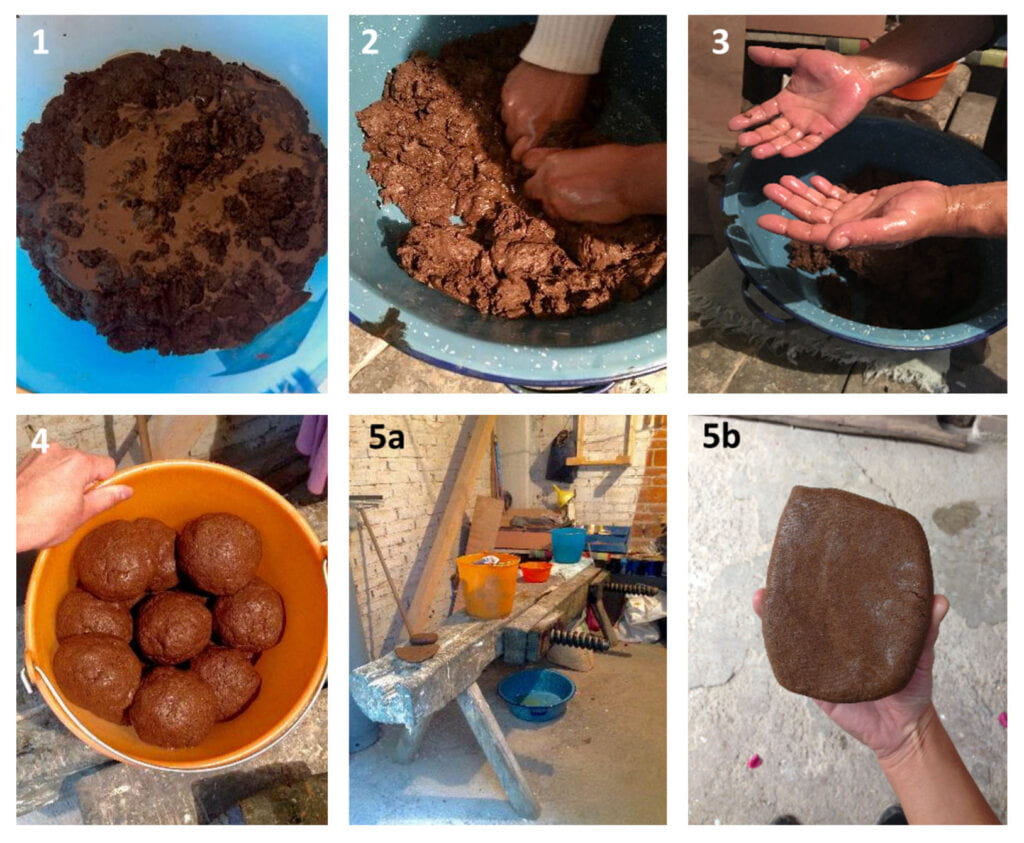
Figure 1: The production of chia oil. 1) toasting, milling and soaking of the chia seeds, 2) kneading, 3) the release of oil, 4) the formation of spheres, and 5a) the pressing of the sphere, where the remainder (b) is used as animal fodder. Photo credit: “author”.
Linaloe oil
As mentioned, wood of the fragrant B. linanoe tree (genus Bursera) is the preferred traditional support material, also sometimes referred to as a “linaloe tree”. This tree grows outside of the Olinalá city limits and is found in the dry forests of Southern Mexico [27]. Often times, the essential oil is extracted to be sold separately or to enhance the scent of boxes made with another type of wood [7,8]. Linalol (also written linalool) is said to exhibit antibacterial and some insecticide effects [28]; it is unclear if this is used as an advantage to help extend the service-life of lacquerware objects. The method of distillation for the sample is unknown; the sample was stored in a glass vial. Essential oil extraction is carried out at an artisanal level from wild plants [27]. The oil on its own is a coveted material. Linalyl acetate is reported as the primary natural component of B. linanoe, and during steam distillation it is converted to 8inalool by thermal hydrolysis [27]. The oils are said to be extracted from wood of wild plants, but it can also be extracted from the fruits [27]. The olfactory properties of 8inalool differ based on their enantiomeric structure: R-(-)-linalool has a fragrance similar to lavender, while the S-(+)-linalool has a fragrance similar to petitgrain [28,29].
Minerals
The landscape around Olinalá is bountiful with sources of natural pigments and fillers. Materials such as indigo, cochineal, iron oxides, anhydrite, and calcium carbonate continue to be locally sourced.
Anhydrite (calcium sulfate anhydride)
Anhydrite (CaSO4) is an anhydrous calcium sulfate and if exposed to water it can convert to gypsum (CaSO4-H2O). This process is reversible by heating to temperatures above 200 degrees Celsius. It is characterized as a soft, crystalline mineral which forms in association with sedimentary rock and marine evaporite deposits [30]. Where it is found in the mineral state, it is more likely to be formed from the heating of gypsum. There are a few known larger anhydrite mines in Mexico, but they are located in the upper central region of the country (e.g. Naica, Chihuahua). Smaller isolated mines may be present through the region and should be further explored. The sample in question (sample approximately 7.5 cm in diameter) was described as coming from a local source, with no supposed heat-treatment processing. It is fine-grained, chalk-like, and bright white. The sample is referred to by its Nahuatl name, Tezicaltetl. Alternative English spelling/translations of this material are tesicalte and tezicaltetli [12]. This material is used without roasting [12,21]. It is not found near Olinalá, rather it is brought from Huamaztitlán, where it is said to be located in ploughed fields [12]. There are reports of this material being purchased in stores in a prepared form [12,19] and it is described as calcite [19].
Calcite
Calcite, the most common form of calcium carbonate, is a polymorphic mineral that occurs in sedimentary, metamorphic, and igneous rocks. It is characterized by its rhomboidal crystal habit and conchoidal fracture pattern [31]. The sample, an unprocessed rock (approximately 10 cm in diameter), came from a local source. It is hard with a notable crystalline growth pattern. The sample is semi-transparent in some areas with streaks of cloudy white and grey. In Olinalá, the mineral was referred to by its Nahuatl name, Toctel. Alternative English spelling/translations of this material are tolto and toctol [12] and toctli [4]. This mineral is typically roasted on embers before use [12,21], and is described as a calcium carbonate [19].
Iron Oxide (ochre)
Iron oxide (ochre) is a naturally occurring inorganic, earth pigment found in multiple forms all over the world. Iron oxides used for pigments consist of a combination of ferrous or ferric oxides and impurities. The ore source is typically not pure and may contain traces of carbonates, feldspar, clays, etc., which can be detected during analysis [30]. The sample, an unprocessed mineral (approximately 4 cm in diameter) was collected directly from a local source. This material, known in Nahuatl as Tecoxtle, is mixed with the oil binder to make chiamate, the base priming coat for all lacquered objects. It is soft and powdery in a rich golden yellow color; a mineral name offered is limonite [19]. Alternative English spelling/translations of this material are tecostle and tecoxtli [4,12,20]. This mineral is typically ground and used without roasting [12,21].
Chiamate (base layer production)
As stated, chiamate is the base (chia oil paste) for the priming layer and is a slurry of oil and pigment. Chiamate was the word used by the local artists to describe this base layer; however, no written references to this have been found. The base layer was noted to be called batido de tecoxtle, and a similar word, chamate, was found to describe linseed oil [12]. It is composed of oil and Tecoxtle (iron oxide). This layer is brushed onto the support. Traditionally, the base layer is a rich black color, and this is achieved by dusting on a mixture of indigo, a white filler and sometimes carbon black using a deer-tail brush (this layer is referred to as tlalpilole [4,19]). The surface is then rubbed/burnished to give a polished texture. This is done with a polished agate, a glass bottle or the palm of a hand. Sometimes the chiamate and the pigment mixture is locally applied to fill in gaps or build up thinly applied areas to ensure the most even coating. It is dusted with the pigment mixture and left overnight. On the following day, it is polished with cotton to “sacar lustre”, which brings out a magnificent luster and it is left to dry for a month. (Figure 2).
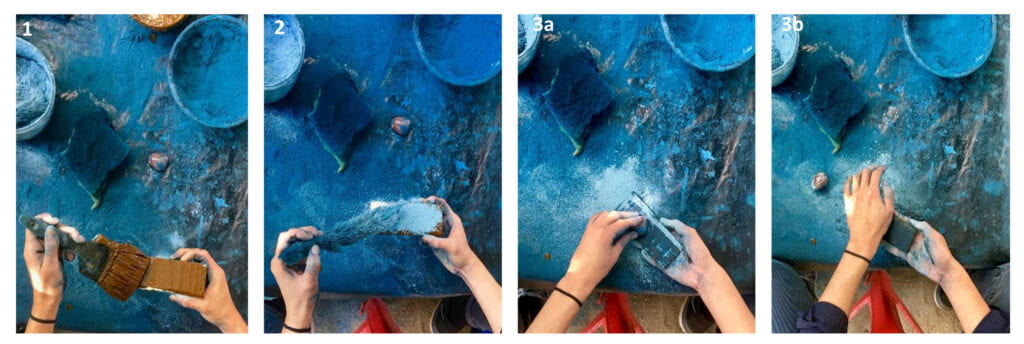
Figure 2: The creation of the base layer. 1) brushing on the chiamate, 2) brushing on the pigment mixture, and 3) the burnishing step a) with agate b) with the palm of a hand. Photo credit: “author”.
Creating a lacquerware piece – tools and additional layers
Regardless of contemporary sources for some of the materials (in particular pigments for the pintado and dorado techniques), the tools remain remarkably unchanged from their traditional origins. There is utilization of deer tails as brushes for dusting on powdered pigments, polished agate for burnishing, turkey feathers fitted with acacia or agave thorns as incising tools, and cat-fur brushes for painting (Figure 3). These tools are also described by Castello Iturbide [12] and Ponce [19].

Figure 3: The traditional tools. 1) Deer tail brush, 2a) a Turkey feather fitted with an acacia or agave thorn 2b), and 3) cat-fur brushes. Photo credit: “author”.
For the incising (rayado) technique, a second colored layer is applied using the same process as described for the base layer, and to achieve the final decoration, the top layer is incised to reveal the lower layer [3,7,8,21]. The traditional incising technique is described in Figure 4, though the white base layer is not traditional, and is more of a contemporary design. Typically, the base layer is a deep blue to black color, while in this example, it is made with titanium dioxide (Figures 4 and 5).
The pintado (punteado) box [32] displays a more typical base color (Figure 5). Analysis (not described in this paper) showed that the black, green and red color were contemporary non-traditional pigments. For example, the blue is Prussian blue, not indigo, though it is done in a traditional pintado (punteado) technique.

Figure 4: The rayado technique. In this case a pink layer is applied over a white base layer. 1) chiamate is applied over the first white base layer, 2) the pink color is brushed on, 3) it is burnished, and 4a, b) the pink layer is incised in a decorative pattern to reveal the white layer below. Photo credit: “author”.
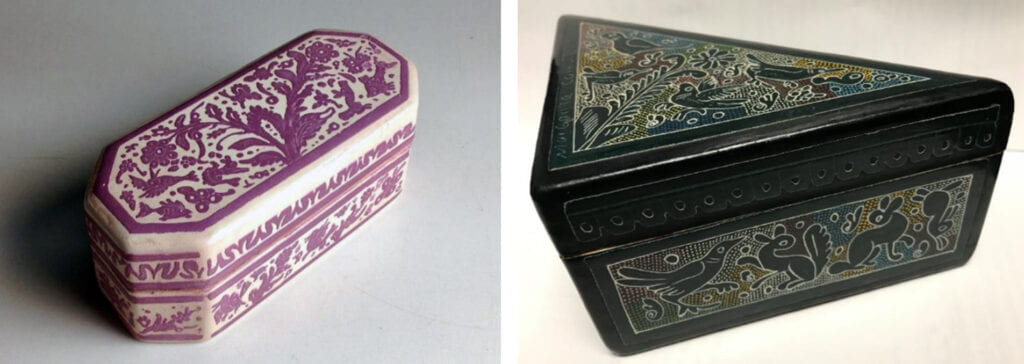
Figure 5: The rayado technique (left) and dorado – punteado technique (right). The rayado lacquerware (made by “author”) uses non-traditional pigments, with the box measuring 15 × 6 × 6 cm. The dorado – punteado lacquerware (purchased) uses non-traditional pigments and is created in a dot-technique illustrating traditional design of fauna; this box is 17 × 12 × 7 cm.
The process of creating lacquerware in Olinalá is also described and photo documented by Leyenaar [4] and described by Castelló Iturbide [10].
These production techniques have similarities to what is described by Cantù [7,8], whereby aje (insect grease) is mixed with a vegetable oil (such as chia or chicalote), along with dolomite (described as also containing silicon and iron oxide). A layer of this paste is applied to the wooden object, allowed to dry, and a second layer of a contrasting color is applied. The dried surface is polished, and a design is created by incising to the contrasting first layer (rayado). Some other techniques involve incising in a cut-and-fill or inlay process, or painting process (pintado and dorado).
Experimental
Fourier transform infrared spectroscopy (FTIR-ATR)
Infrared spectra were collected using a Nicolet 6700 FTIR spectrometer (Thermo Scientific) with a Thermo Scientific Smart iTR ATR accessory. Samples were analyzed by pressing them against the Diamond ATR crystal. The spectra are the average of 32 scans at 4 cm-1 spectral resolution. Sample identification was aided by searching a spectral library of common conservation and artists’ materials (Infrared and Raman Users Group, http://www.irug.org) using Omnic software (Thermo Scientific).
Raman Spectroscopy
Dispersive Raman spectra were collected on a Bruker Senterra Raman microscope using a 785 nm excitation laser operating at a power of 10 mW at the source. A 10x objective was used to focus the excitation beam to an analysis spot of approximately 10 mm directly onto a micro-sample placed on a microscope slide. The resulting Raman spectra are the average of 60 scans at 1 sec integration each. Spectral resolution was 9-15 cm-1 across the spectral range analyzed. Spectral spikes due to cosmic rays were removed and baselines adjusted as necessary using Opus 7.5 software. Sample identification was achieved by comparison of the unknown spectrum to spectra of reference materials.
Pyrolysis – gas chromatography – mass spectrometry (py-GC-MS)
A Frontier Lab Py-2020iD double-shot pyrolyzer system was used for pyrolysis, and the pyrolysis interface was maintained at 320 oC. The pyrolyzer was interfaced to an Agilent Technologies 7820A gas chromatograph coupled to a 5975 quadrupole mass spectrometer. A Phenomenex ZB-5Msi (5%-phenyl-95%dimethypolysiloxane) column (30 m length x 0.25 mm i.d. x 0.25µm film thickness) was used for the separation with ultra-high purity helium (UHPHe) as the carrier gas set to 1 mL/min. The split injector was set to 320 oC with a split ratio of 20:1. The MS transfer line was at 320 oC, the source at 250 oC, and the MS quadrupole at 150 oC. The mass spectrometer was scanned from 33-600 amu at a rate of 2.59 scans per second. The electron multiplier was set to the autotune value.
Samples were placed into a 50 µL stainless steel Eco-cup and 3 µL of a 25% methanolic solution of tetramethylammonium hydroxide (TMAH) was introduced for derivatization. Afterwards, an Eco-stick was fitted into the cup, and the cup was placed into the pyrolysis interface where it was purged with He for 3 minutes.
Samples were pyrolyzed using a single-shot method at 600 oC for 10 seconds. The GC oven temperature program was 50 oC for 2 minutes, then ramped to 300 oC at 10 oC per minute, followed by a 5 minute isothermal period, with an initial solvent delay of 2 minutes.
Sample identification was aided by searching the NIST MS library (NIST Search 2.0, 2009) and ChemStation software (MSD ChemStation E.02.01.1177).
Scanning Electron Microscopy and Energy Dispersive X-ray Spectroscopy (SEM-EDS)
Secondary electron and backscatter electron images were obtained using a Tescan Vega3 XMU tungsten variable pressure scanning electron microscope. Samples were analyzed under high vacuum. The accelerating voltage used was 15 kV. X-ray spectra were collected and processed using an Oxford Instruments 50 mm2 X-Maxn Silicon Drift Detector (SDD) and AztecEnergy analysis software. Samples were carbon coated to reduce surface charging.
Polarized light microscopy (PLM)
A Leica DM750P polarized light microscope was used to characterize three unidentified minerals. Fine particles were excavated from the source material without further grinding. Trace amounts of each material was mounted on to glass slides using MeltMount (nD25= 1.662). Particles were observed in transmitted, plane-polarized light (PPL), in cross polarized light (XPL), and with a quartz quarter plate compensator (147nm). Optical effects were recorded including: morphology, average particle size, color, refractive index (n), birefringence, (an)isotropy, interference colors, sign of elongation, pleochroism, and extinction angle. Detecting such attributes with PLM is a method proven to assist in characterizing and identifying unknown pigment particles. The traits of the samples were compared with published characteristics.
Results and discussion
The organic components
Chia oil
Based on the documentation of the oil collection processes, it was known that the oil was chia oil. Chia oil is mainly composed of linoleic and linolenic acids (together above 80%), while palmitic acid is approximately 7%, stearic acid 3%, and oleic 7-10.5% [25,26].
As the seeds are toasted (heated) and the extraction process takes several days, it is expected that the ratios of linoleic and linolenic acids, as well as some oleic acid may be altered as oxidation processes begin. Using py-GC-MS, a small amount of azelaic acid was noted in the fresh toasted chia oil (liquid), while there was a significant amount present in the dried (tacky solid) chia oil, as well as the expected changes is the ratios of monounsaturated and polyunsaturated fats, primarily oleic, linoleic, and linolenic acids. A number of other oil ageing products were observed, including suberic acid and sebacic acid (Figure 6). The calculated palmitic-to-stearic acid (P/S) ratio was 1.9 (based on peak height and the dried film), which is close to the correct range for chia oil based on the literature; 1.6 – 2.3 based on fatty acid profiles [25,26]. Other saturated and monounsaturated fats observed and noted to be present in chia oil [33] were behenic acid, lignoceric acid, and eicosanoic acid (both in the fresh and dried films). The fresh chia oil contained the expected amounts of linoleic and linolenic acids, as well as β-sitosterol, a phytosterol noted in chia oil [25,26,33].
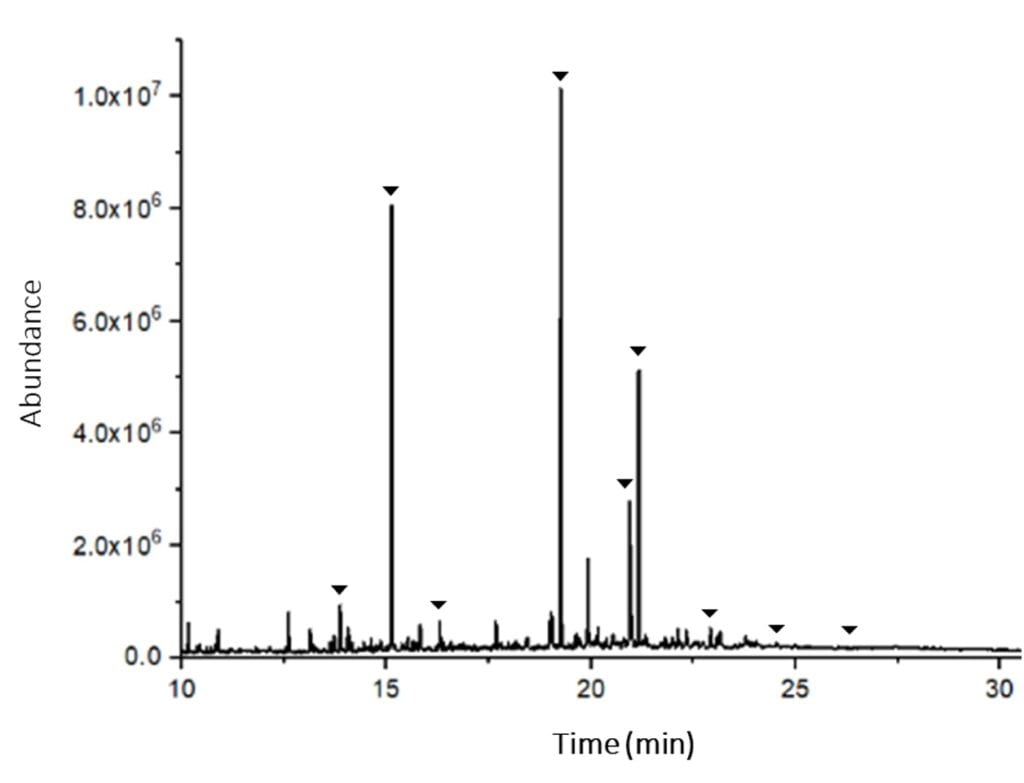
Figure 6: The chromatogram for the aged chia oil (from 10-30min). Presented are the methylated peaks for suberic acid (R.T. 13.9 min), azelaic acid (R.T. 15.1 min), sebacic acid (R.T. 16.3 min), palmitic acid (R.T. 19.3 min), oleic acid (R.T. 20.9 min), stearic acid (R.T. 21.1 min), eicosanoic acid (R.T. 22.9 min), behenic acid (R.T. 24.6 min), and lignoceric acid (R.T. 26.1 min).
ATR-FTIR (Figure 7) showed evidence of additional oxidation between the fresh chia oil (liquid) and a dried sample (tacky solid). This was observed particularly in the hydroxyl (3300-3100 cm-1) and carbonyl region (1740 cm-1), as well as the decrease of the C-H stretching at points of unsaturation (3012cm-1). These are typical changes associated with the oxidation of oils.
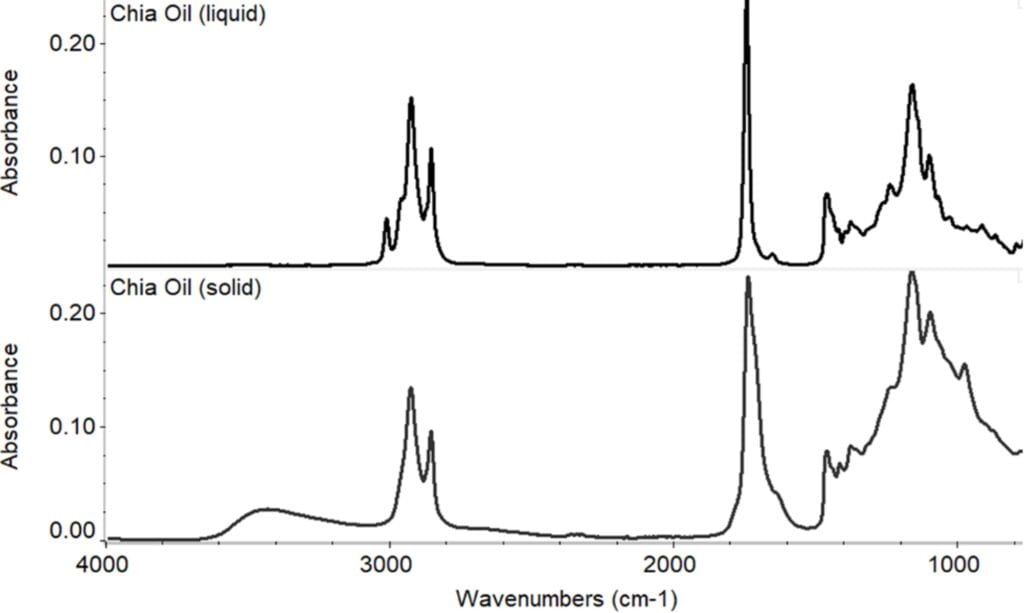
Figure 7: The oxidation of chia oil.
Linaloe oil
This material is not used in the manufacture of lacquerware; however, the wood serves as a traditional support material, and sometimes the oil is extracted and sold separately to enhance the scent of the constructed boxes. Linaloe oil is not a triglyceride, but rather an essential oil, mainly composed of the fragrant unsaturated monoterpenoid alcohol, 15inalool. Linalol is an enantiomer pair of terpene alcohol S-(+)- and R-(-)- 3,7-dimethyl-1,6-octadien-3-ol [28,29]. Linalol was confirmed with py-GC-MS. The liquid linaloe showed a series of peaks for monoterpene based alcohols, where the main peaks were 15inalool, plinols, terpineol, nerol, and lemonol. As plinols, terpineol, nerol and lemonol are typically not associated with linaloe [27], it is thought that they are products from the distillation process and/or thermal pyrolysis; this requires additional studies for confirmation. An unknown factor is whether the linaloe oil was adulterated with other essential oils or materials prior to being sampled, since the extraction and distillation processes were not observed.
ATR-FTIR (Figure 8) showed potential evidence of oxidation and a non-volatile natural gum material between the fresh linaloe oil (liquid) and a dried sample (solid). Several of the compounds are volatile, hence the coveted fragrance, otherwise it can oxidize to form various oxidation products [29].
The liquid linaloe oil contains carbonyl species, which suggests that linalyl acetate (an ester) and limonal (an aldehyde) or other species, may be present in the fresh sample. There is evidence of a tertiary alcohol, corroborating the presence of 15inalool, as supported by the hydroxyl O-H stretching peak (3300-3100cm-1), a peak around 1376cm-1 representing O-H deformation (def.) and a peak around 1113 cm-1 for C-O, stretching (str.).
The solid film linaloe oil showed changes throughout the spectrum. There is a general decrease in C-H stretching peaks (3100- 2700 cm-1), as well as decreases in peaks likely attributed to mono-substituted alkenes (vinyl: RHC=CH2)—around 3094 cm-1 (CH2(C-H) str.), 3008 cm-1 (CHR(C-H) str.), 1643 cm-1 (C=C str.), and 920 cm-1 (C-H def.)—and other peaks likely attributed to di- and tri-substituted alkenes species—3053cm-1 (C-H str.), 996 cm-1 (C-H def.), 838 cm-1 (C-H def.) and 802 cm-1 (CH-H def.)—are evidence of potential loss of volatile species and/or of ageing (oxidation). The change and broadening of the carbonyl peak may also be due to the loss of volatile species (for example, a small peak at 2733 cm-1 likely attributed to the C-H str. asym. of an aldehyde that is no longer present in the aged sample) and the formation of oxidation products, such as hydroperoxides. The formation of hydroperoxides is supported by the change and broadening in the O-H str. Peak (3300-3100 cm-1). In the case of 15inalool, the formation of hydroperoxides (autocatalytic, as there is potential hydrogen abstraction by the peroxy radical from the same or neighboring molecule) and a shift of the tri-substituted C=C (C6-C7) has been reported; a number of hydroperoxide products were identified where the reaction with O2 occurs in the vicinity of the aforementioned C=C [29]. It is suspected that other monoterpene-based molecules may also undergo similar oxidation reactions.
The py-GC-MS data for the solid film showed evidence of saccharides, suggesting the presence of natural carbohydrates in the linaloe oil. Their presence (likely as a non-volatile residue) may also account for the changes in the spectrum, specifically in the O-H region (O-H str.) and fingerprint region (likely C-O str. Around 1070 cm-1).
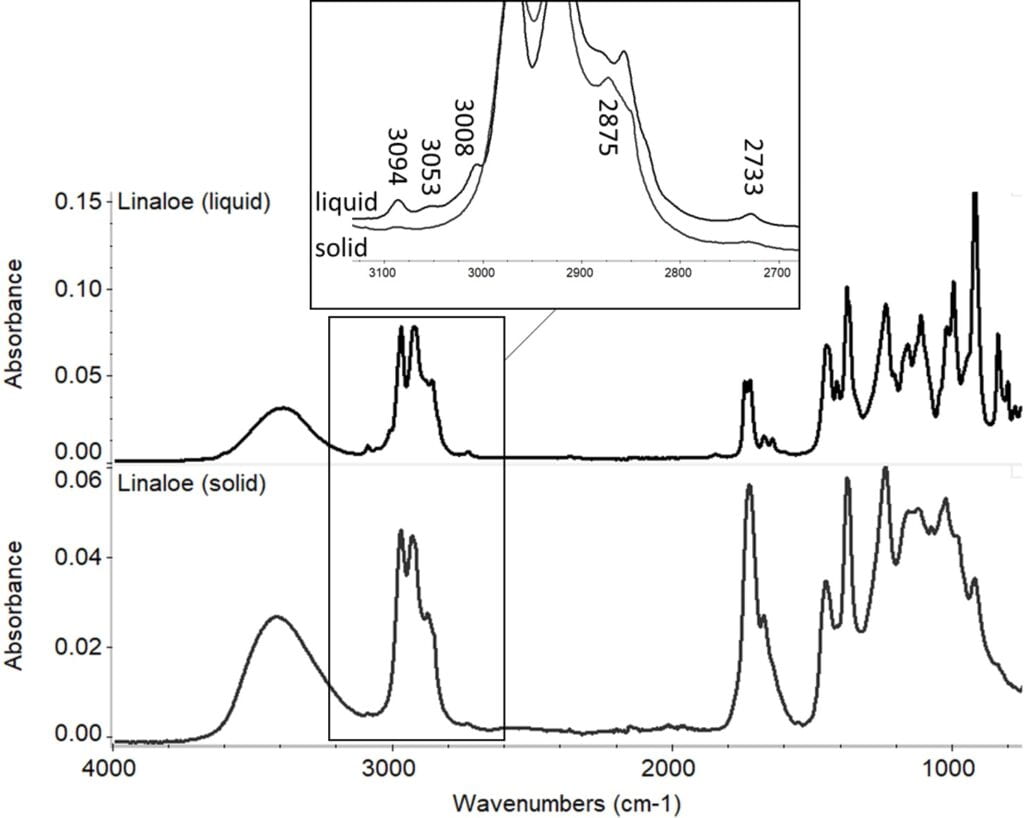
Figure 8: The loss of volatiles and oxidation of linaloe oil.
The inorganic components (Figure 9)
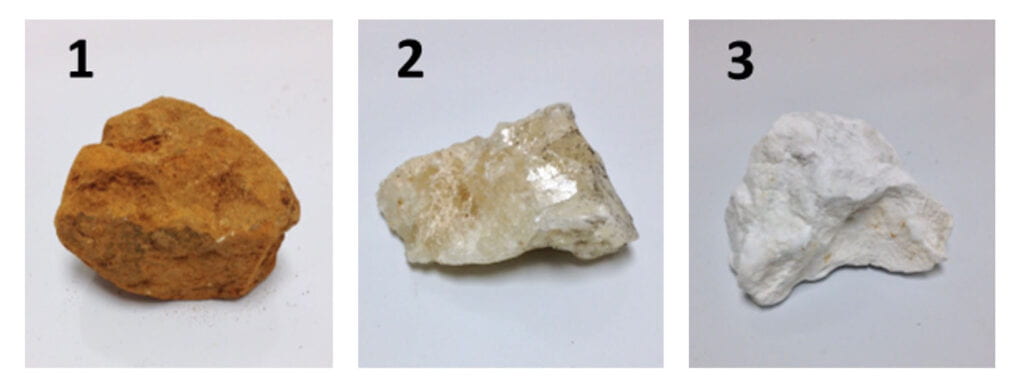
Figure 9: The three inorganic components. 1) iron oxide (specimen 4 cm in diameter), 2) calcite (specimen 10cm in diameter), and 3) anhydrite (specimen 7.5cm in diameter).
Iron oxide (ochre)
This yellow mineral pigment is mixed with the chia oil to make chiamate, which is the base coat for the lacquerware, and used in all the layers. By the color, it was assumed this was an iron oxide based mineral. This was confirmed with FTIR, PLM and SEM-EDS. Using PLM a mixture of materials, including flat, clay like particles as well as crystalline rods were identified (Figure 10). These structures were also observed with SEM-EDS; the elemental content indicated iron (2 % weight), aluminum (30 % weight), and a silicate (38 % weight oxygen and 28 % weight silicon), concluding that this is likely an iron-rich clay.
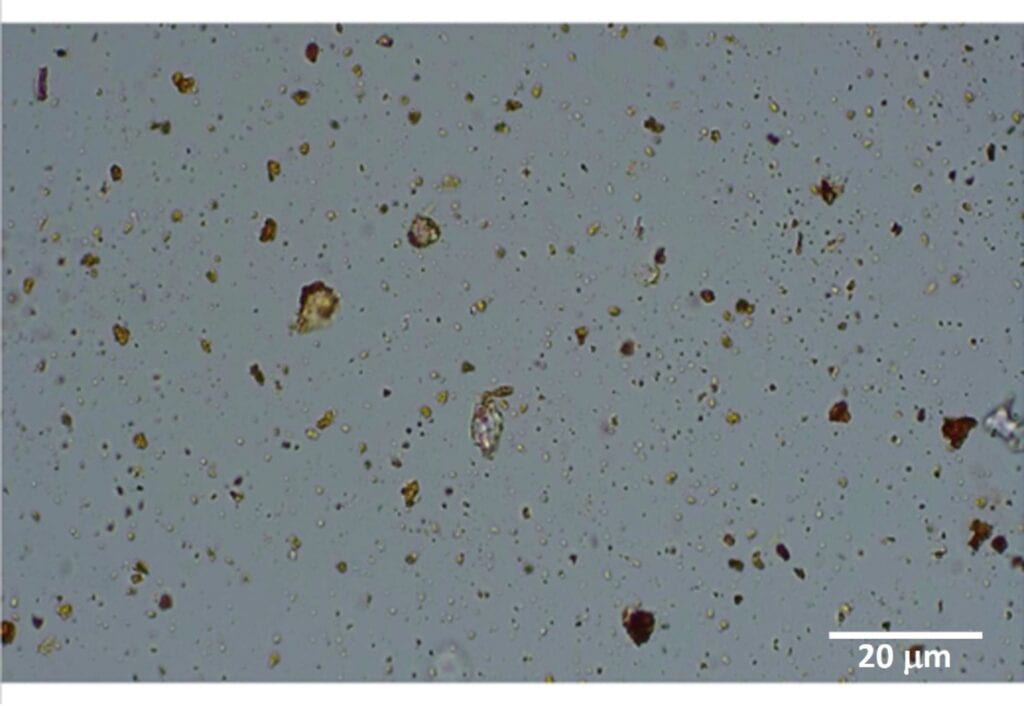
Figure 10: Polarized light microscopy (20x) of the iron oxide. Large flat particles and rods are observed.
Calcite
This transparent faint pink mineral is crushed and processed into a white pigment and is mixed in indigo base layer. By the color and context, it was assumed this was a calcium carbonate-based mineral. This was confirmed with FTIR and Raman spectroscopy (Figure 11).
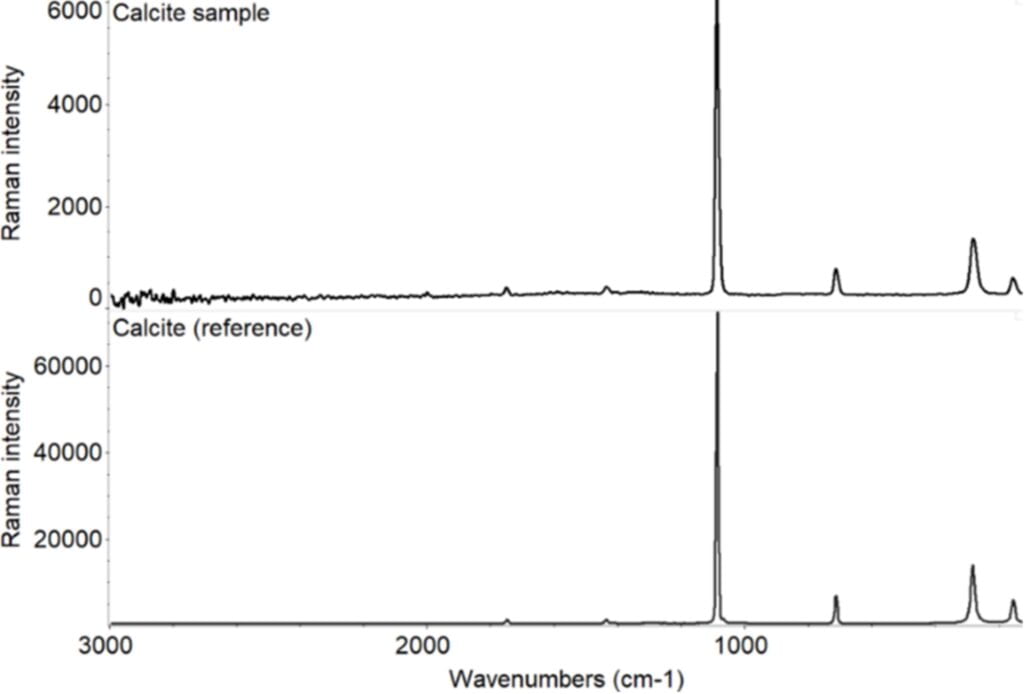
Figure 11: Raman spectrum of the calcite. Above is the sample (collected at 785nm) and below is a reference sample from the RRUFF database, RRUFF ID R050070 [34].
Anhydrite (calcium sulfate anhydride)
This soft and powdery mineral is crushed and processed into a white pigment/extender and is also mixed in indigo base layer (Figure 12). It was originally assumed to be talc based on the physical properties. SEM-EDS showed rod and rhomboidal structures not typically associated with talc (Figure 13). FTIR and Raman spectroscopy were used to confirm that the sample was anhydrite, or a calcium sulfate anhydride (Figure 14). With FTIR the strongest spectral peak at 1095 cm-1 is likely the ν3 antisymmetric stretch of the SO4 tetrahedra, while the peaks at 672, 610, and 592 cm-1 are the antisymmetric bending vibrations. The small peak at 1015 cm-1 is the ν1 symmetric stretch of the SO4 tetrahedra [35 ,36]. With Raman spectroscopy the strongest spectral peak at 1016 cm-1 is the ν1 symmetric stretch of the SO4 tetrahedra, and the peaks at 498 and 416 cm-1 are the ν2 symmetric bending, the peaks at 1160, 1129, and 1110 cm-1 are the ν3 antisymmetric stretch and the peaks at 675, 627, and 610 cm-1 are the ν4 antisymmetric bending modes [36]. The peaks above 1200 cm-1 are assumed to be impurities or residual hydration (from the gypsum) and were not identified.
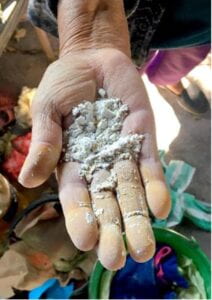
Figure 12: The crushed anhydrite. Photo credit: “author”.
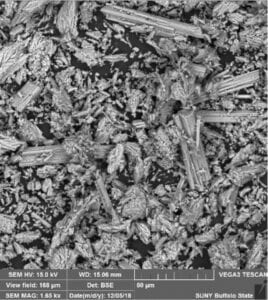
Figure 13: SEM-EDS of the anhydrite showing rod and rhomboidal structures.
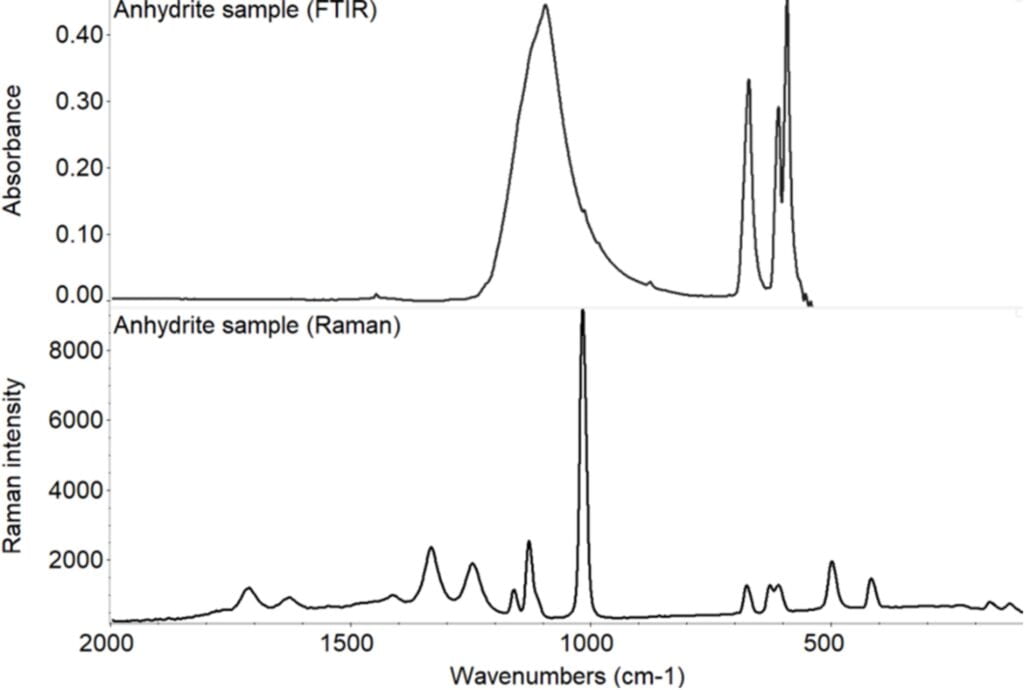
Figure 14: The FTIR and Raman spectra for the anhydrite sample.
Conclusions
The goal of this study was to document and identify as best as possible a selection of currently locally sourced traditional materials and how they are used for lacquerware production in Olinalá, Guerrero. Understanding the nature of the materials can help conservators, who may be required to treat such objects, determine methods of treatment. As well, the characterization of materials and documentation of culture knowledge merge tangible and intangible knowledge and are recorded and shared here for posterity. Through the combined efforts of ethnohistorical and scientific analyses, contemporary materials were successfully identified for lacquer object fabrication; several components including minerals and organic media were locally sourced. Comparative analysis of the media and pigments could help identify the local materials used on the oldest Mexican lacquerware artifacts. The authors recognize the generosity of the artisans of Olinalá and are grateful for their openness to share their knowledge; there is an immense respect for their historic craft and a desire for preserving it, despite noted hardships. It is hoped that this will, in some way, contribute towards the awareness, recognition, and preservation of this ancient craft.
An interesting aspect of this collaborative research (anthropological, art historical, and scientific) involving this art form is the inconsistency in the nomenclature of the materials encountered throughout the reference literature. This can make identification of the materials employed in the fabrication of lacquerware difficult. It is hoped that this research will contribute toward a consistent language. It is this type of conservation and research that provides the opportunity to facilitate cross-cultural relationships and has the potential to serve as an educational tool in forging new pathways of collaboration with adjacent fields and cultural communities outside the museum.
Acknowledgements
This work could not have been possible without the generosity of the artisans and their families who graciously opened their homes to “the author”. Specifically, we acknowledge the Garcia Escudero, Navas Gonzales, Abarca Hernandez, Coronel Navaro, Fausta Reyes families of Olinalá, as well as Instituto de Capacitación para el Trabajo Olinalá (ICAT), who took the time to teach “the author” about this age-old craft and provided the materials for this study. Thank you to Jonathan Thornton at the Garman Art Conservation Department at SUNY Buffalo State, whose class assignment served as the genesis for this project. Finally, special recognition and gratitude is extended to Rosanna Anaya who aided with translation and documentation, and whose intrepid spirit made it possible to visit Olinalá.
Endnotes
[1] Lechuga, R. and Museo Franz Mayer, eds. Lacas Mexicanas. Colección Uso y Estilo 5. México: Museo Franz Mayer : Artes de México, 1997. [2] Orellana, M. de, and A. Ruy Sánchez, eds. The Crafts of Mexico. Washington, D.C: Smithsonian Books : Artes de México, 2004. [3] Konan, M.A. “A Lustrous Tradition.” Américas 3 (1984): 2–3; 46–49. [4] Leyenaar, T.J.J. “Mexican Lacquers from Guerrero / La Laca Mexicana de Guerrero.” National Museum of Ethnology Museum Volkenkunde, N.D. https://www.yumpu.com/en/document/read/7804101/mexican-lacquers-from-guerrero-museum-volkenkunde/1. [5] Oettinger, M. Folk Treasures of Mexico: The Nelson A. Rockefeller Collection in the San Antonio Museum of Art and the Mexican Museum, San Francisco. New York: Abrams, 1990. [6] Pérez Carrillo, S. and C. Rodríguez de Tembleque. “Influencias Orientales y Europeas.”, in Lacas Mexicanas. Colección Uso y Estilo 5. México: Museo Franz Mayer : Artes de México, 1997. [7] de Cantú, G.R. “The Survival of an Art Form.” Artes de México, no. 190 (1976): 99–101. [8] de Cantú, G. R. “Supervivencia de un Arte.” Artes de México, no. 190 (1976): 41-52. [9] Ayerza, R. and W. Coates. Chía: redescubriendo un olvidado alimento de los aztecas. Buenos Aires: Editorial del Nuevo Extremo, 2006. [10] Cahill, J.P. “Ethnobotany of Chia, Salvia Hispanica L. (Lamiaceae).” Economic Botany 57, no. 4 (2003): 604–18. [11] Medina González, I. “¿Maque Prehispánico? Una Antigua Discusión.” In Lacas Mexicanas. Colección Uso y Estilo 5. México: Museo Franz Mayer : Artes de México, 1997. [12] Iturbide, T.C. “Maque (Laquer).” Artes de México, no. 153 (1972): 92–101. [13] Author Unknown. “Lacquer Renaissance in Mexico.” Bulletin of the Pan American Union 82, no. 6 (1948): 348–52. [14] Jolly, J. Creating Pátzcuaro, Creating Mexico: Art, Tourism, and Nation Building under Lázaro Cárdenas. Austin: University of Texas Press, 2018. [15] Bravo Marentes, C. and M. Turok Wallace. “Patrimonio Artesanal En Riesgo.” In Lacas Mexicanas. Colección Uso y Estilo 5. México: Museo Franz Mayer : Artes de México, 1997. [16] Suazo-Ortuño, I., E. del Val-De Gortari, and J. Benítez-Malvido. “Rediscovering an extraordinary vanishing bug: Llaveia axin axin”, Revista Mexicana de Biodiversidad 84, no. 1 (2013): 338-346. [17] Merlin, J. “In Olinala, Crafting Lacquerware is Way of Life.” Los Angeles Times. January 20, 1991. [18] Footnote: The artisans mentioned that sustaining this practice had been hard at different times due to many reasons: bureaucracy, prejudice, the merchants do not want to accept the items because of conditions of the greater market, because merchants did not offer enough for their goods. As well, artisans that cannot afford to make the journey to larger centers to sell their wares often consider if continuing to make the work is worthwhile. In times of political unrest or violence it can be extra dangerous to travel. (notes from “the author”, January 2018) [19] Ponce, B. R. “Rescatando y Protegiendo La Artesanía de Olinalá, Patrimonio Cultural de México.” Guerrero, Mexico: Instituto de Capacitación para el Trabajo del Estado de Guerrero (ICAT), 2011. https://ibero.mx/campus/publicaciones/enelcamino/pdf/Rescatando_y_protegiendo_la_artesania_de_Olinala.pdf [20] Belejack, B. “Shopper’s World; Colorful Folk Motifs in Mexico’s Lacquerware.” New York Times. May 27, 1990. [21] Footnote: Observations by “author”, January 2018. [22] Vázquez de Ágredos Pascual, M. L., Carbó. T.D., and A. D. Carbó. “Resins and Drying Oils of Pre-Columbian Paintings: A Study from Historical Writings. Equivalences to Those of European Painting.” Arché 3 (2008): 185–90. [23] Haugen, J.D. “Borrowed Borrowings: Nahuatl Loan Words in English.” Lexis, no. 3, (2009), 63-106. [24] “Online Nahuatl Dictionary.” University of Oregon, 2000. https://nahuatl.wired-humanities.org/node/175205 [25] Ayerza, R. “Effects of Seed Color and Growing Locations on Fatty Acid Content and Composition of Two Chia (Salvia hispanica L.) Genotypes.” Journal of the American Oil Chemists’ Society 87, no. 10 (2010): 1161-65. [26] Ayerza, R., and W. Coates. “Protein Content, Oil Content and Fatty Acid Profiles as Potential Criteria to Determine the Origin of Commercially Grown Chia (Salvia Hispanica L.).” Industrial Crops and Products 34, no. 2 (2011): 1366-71. [27] Becerra, J.X. and K. Noge. “The Mexican Roots of the Indian Lavender Tree.” Acta Botanica Mexicana, 91 (2010): 27-36. [28] Kamatou, G.P.P. and A.M. Viljoen. “Linalool – a Review of a Biologically Active Compound of Commercial Importance.” Natural Product Communications 3, no. 7 (2008): 1183-92. [29] Bäcktorp, C., J. Wass, I. Panas, M. Sköld, A. Börje, and G. Nyman. “Theoretical Investigation of Linalool Oxidation.” Journal of Physical Chemistry A 110, no. 44 (2006): 12204-12. [30] Eastaugh, N., V. Walsh, T. Chaplin, and R. Siddall. Pigment Compendium: A Dictionary of Historical Pigments. Routledge, 2007. [31] Gettens, R. J., E.W. Fitzhugh, and R. L. Feller. “Calcium Carbonate Whites.” In Artists’ Pigments: A Handbook of Their History and Characteristics, edited by R. Ashok , Vol. 2. Washington: National Gallery of Art, 1993. [32] Purchased on eBay with paperwork from Galeria Indigena. [33] Kulczyński, B., J. Kobus-Cisowska, M. Taczanowski, D. Kmiecik, and A. Gramza-Michałowska. “The Chemical Composition and Nutritional Value of Chia Seeds—Current State of Knowledge.” Nutrients 11, no. 6 (2019): 1242-57. [34] Lafuente B., R.T. Downs, H. Yang, and N. Stone. “The Power of Databases: The RRUFF Project.” In Highlights in Mineralogical Crystallography, edited by T. Armbruster and R.M. Danisi, 1–30. Berlin, Germany: W. De Gruyter, 2015. https://rruff.info/calcite/display=default/R040070. [35] Bishop, J. L., M.D. Lane, M.D. Dyar, S.J. King, A. J. Brown, and G.A. Swayze. “Spectral Properties of Ca-Sulfates: Gypsum, Bassanite, and Anhydrite.” American Mineralogist 99, no. 10 (2014): 2105–15. [36] Liu, Y., A. Wang, and J.J. Freeman. “Raman, MIR, and NIR Spectroscopic Study of Calcium Sulfates: Gypsum, Bassanite, and Anhydrite.” In 40th Lunar and Planetary Science Conference. Texas, 2009.Author Bio
Tamia Anaya is a conservator at the Getty Research Institute where she leads the conservation efforts for the Paul Revere Williams and Claes Oldenburg and Coosje van Bruggen archives. Tamia’s practice as a conservator is informed by her Kichwa and Mexican background, a lens through which she examines the social and ethical responsibilities that come with working in a cultural heritage institution. In her range of interests from studying Mexican artesanías to learning about the innovative ways in which contemporary artists utilize paper, Tamia strives to highlight the work of historically overlooked figures in museums and libraries. Beyond material studies and hands-on treatments, Tamia is deeply committed to reimagining the boundaries of traditional conservation and expanding the scope of collaboration with conservation-adjacent fields.
